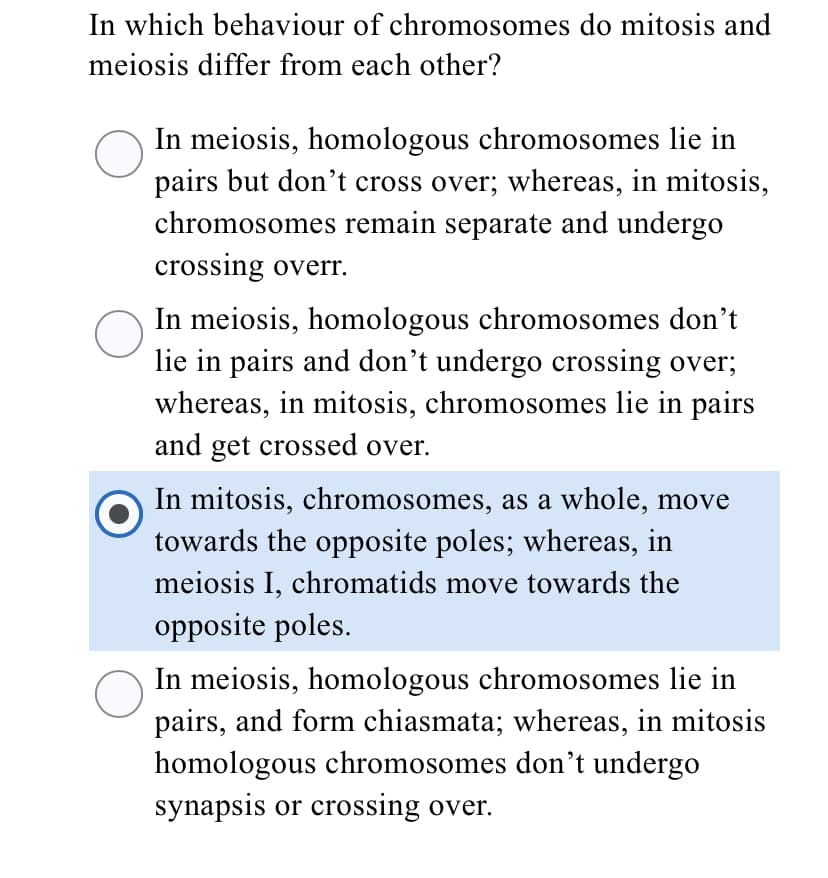In which behaviour of chromosomes do mitosis and meiosis differ from each other? In meiosis, homologous chromosomes lie in pairs but don't cross over; whereas, in mitosis, chromosomes remain separate and undergo crossing overr. In meiosis, homologous chromosomes don't lie in pairs and don't undergo crossing over; whereas, in mitosis, chromosomes lie in pairs and get crossed over. In mitosis, chromosomes, as a whole, move towards the opposite poles; whereas, in meiosis I, chromatids move towards the opposite poles. In meiosis, homologous chromosomes lie in pairs, and form chiasmata; whereas, in mitosis homologous chromosomes don't undergo synapsis or crossing over.
In which behaviour of chromosomes do mitosis and meiosis differ from each other? In meiosis, homologous chromosomes lie in pairs but don't cross over; whereas, in mitosis, chromosomes remain separate and undergo crossing overr. In meiosis, homologous chromosomes don't lie in pairs and don't undergo crossing over; whereas, in mitosis, chromosomes lie in pairs and get crossed over. In mitosis, chromosomes, as a whole, move towards the opposite poles; whereas, in meiosis I, chromatids move towards the opposite poles. In meiosis, homologous chromosomes lie in pairs, and form chiasmata; whereas, in mitosis homologous chromosomes don't undergo synapsis or crossing over.
Biology Today and Tomorrow without Physiology (MindTap Course List)
5th Edition
ISBN:9781305117396
Author:Cecie Starr, Christine Evers, Lisa Starr
Publisher:Cecie Starr, Christine Evers, Lisa Starr
Chapter8: How Cells Reproduce
Section: Chapter Questions
Problem 12SQ
Related questions
Concept explainers
Oogenesis
The formation of the ovum (mature female gamete) from undifferentiated germ cells is called oogenesis. This process takes place in the ovaries (female gonads). Oogenesis consists of three stages known as the multiplication phase, growth phase, and maturation phase.
Cell Division
Cell division involves the formation of new daughter cells from the parent cells. It is a part of the cell cycle that takes place in both prokaryotic and eukaryotic organisms. Cell division is required for three main reasons:
Question
100%

Transcribed Image Text:In which behaviour of chromosomes do mitosis and
meiosis differ from each other?
In meiosis, homologous chromosomes lie in
pairs but don't cross over; whereas, in mitosis,
chromosomes remain separate and undergo
crossing overr.
In meiosis, homologous chromosomes don’t
lie in pairs and don't undergo crossing over;
whereas, in mitosis, chromosomes lie in pairs
and get crossed over.
In mitosis, chromosomes, as a whole, move
towards the opposite poles; whereas, in
meiosis I, chromatids move towards the
opposite poles.
In meiosis, homologous chromosomes lie in
pairs, and form chiasmata; whereas, in mitosis
homologous chromosomes dont undergo
synapsis or crossing over.
Expert Solution
This question has been solved!
Explore an expertly crafted, step-by-step solution for a thorough understanding of key concepts.
This is a popular solution!
Trending now
This is a popular solution!
Step by step
Solved in 4 steps with 2 images

Knowledge Booster
Learn more about
Need a deep-dive on the concept behind this application? Look no further. Learn more about this topic, biology and related others by exploring similar questions and additional content below.Recommended textbooks for you

Biology Today and Tomorrow without Physiology (Mi…
Biology
ISBN:
9781305117396
Author:
Cecie Starr, Christine Evers, Lisa Starr
Publisher:
Cengage Learning

Human Biology (MindTap Course List)
Biology
ISBN:
9781305112100
Author:
Cecie Starr, Beverly McMillan
Publisher:
Cengage Learning

Human Heredity: Principles and Issues (MindTap Co…
Biology
ISBN:
9781305251052
Author:
Michael Cummings
Publisher:
Cengage Learning

Biology Today and Tomorrow without Physiology (Mi…
Biology
ISBN:
9781305117396
Author:
Cecie Starr, Christine Evers, Lisa Starr
Publisher:
Cengage Learning

Human Biology (MindTap Course List)
Biology
ISBN:
9781305112100
Author:
Cecie Starr, Beverly McMillan
Publisher:
Cengage Learning

Human Heredity: Principles and Issues (MindTap Co…
Biology
ISBN:
9781305251052
Author:
Michael Cummings
Publisher:
Cengage Learning